In a world pushing “do more, faster,” the key to protecting your time may be a simple, powerful word: no. Mastering when saying no is a time-protection strategy empowers you to shield your calendar from distractions and prioritize what truly matters—with confidence and clarity.

Why “No” Is the Secret to Time Protection
1. Saying No Frees Up Your Calendar for What Matters
Experts note that by declining low-priority tasks, we create space for high-value work—helping us direct our energy where it counts most. In professional settings, this means focusing on key projects rather than being reactive.
2. Guarding Your Mental Energy
Research shows that time management—not just productivity—enhances well-being significantly. Constant yeses fragment focus, leading to burnout. Saying no protects mental clarity and reduces stress.
3. “No” Is a Productivity Tool, Not a Blocker
As productivity author James Clear puts it: “If you don’t guard your time, people will steal it”. Saying no isn’t rejection—it’s clarity. It helps you invest in tasks aligned with your goals.
Emerging Trends: Why Saying No Matters More Now
Trend 1: Flexible Work Means More Interruptions
With hybrid and remote setups, work bleeds into personal time. Over 43% of flexible workers report higher productivity—but also struggle with boundary fuzziness. Saying no to off-hours tasks is now essential.
Trend 2: Digital Distractions Are Non‑Stop
We spend ~6.5 hours daily on our devices. Automatic yeses to every invite or ping lead to fractured attention. Saying no, or even muting pings, defends your time in a digital storm.
Trend 3: Burnout Is a Global Concern
Overwork is linked to serious health issues like depression and heart disease. Recent stories highlight how people in crisis recovered by learning to say no and set firm boundaries .
How Saying No Becomes a Strategy—Not a Struggle
1. Define Your Priorities Clearly
Start with core goals. Use tools like timeblocking to map focus blocks—and guard them with a firm no. This makes saying no easier because you’re working toward defined objectives.
2. Use Structured Refusals
Harvard Business Review suggests crafting thoughtful refusals that protect relationships:
“Thanks for thinking of me, but I can’t commit right now.”
These clear yet polite responses uphold your boundaries without burning bridges.
3. Build a “No List”
Identify recurring drains—unnecessary meetings, recurring asks that don’t move the needle. Psychotherapists recommend keeping a mental “No List” and reviewing it before agreeing.
4. Script It in Advance
Write common no-responses like: “I don’t have bandwidth this week, but let’s revisit next month.” This avoids apology overload and reinforces that saying no is about time protection—not refusal.
5. Guard Time with Tech
Schedule “focus time” in your calendar and communicate it. Disable push notifications for email/social during that slot. A study found that removing notifications boosts productivity—though some feel less connected.
Real‑World Wins from Saying No
- Justin Stewart’s Awakening
Handling multiple jobs landed him in the hospital—until he learned to say no to side gigs—and regained control. His story shows that saying no can be life-saving. - Leaders Who Lean In
4 Leaf Performance reports leaders who decline low-impact work maintain clarity for high-return projects, avoid burnout, and sharpen decision-making. - Creative Professionals Reclaim Their Flow
Creatives report that saying no preserves “deep work” time—boosting both quality and enjoyment of their craft.
A Practical Guide: Saying No as a Time-Protection Strategy
- List Your Top 3 Priorities
- Align commitments with these. Any ask not in sync requires a planned no.
- Timeblock Your Focus Windows
- Allocate undisturbed time. Add buffers. Treat them as unbreakable events on your calendar.
- Prepare “No Scripts”
- “I’m focusing on big deliverables right now, so can’t add more.”
- Practice tone—honest and respectful.
- Review New Requests Against Goals
- Pause before saying yes. Ask: “Does this align?”
- Communicate Your Boundaries
- Let others know your working hours; use email footers or status updates to signal availability.
- Reflect Weekly
- Ask: Which meetings/tasks drained me? What did I learn to say no to—and how did that benefit my focus?
Overcoming the “Yes” Habit
| Common Barrier | Reframe with Time‑Protection |
|---|---|
| Fear of disappointing | “I’m prioritizing, not rejecting.” |
| Hustle culture pressure | “Saying no sustains my high performance.” |
| Imposter syndrome | “My time is my authority; I protect it responsibly.” |
As organizational coach Cara Houser notes, you don’t owe explanations—just a firm, respectful refusal wins out.
Conclusion: Say No to Say Yes
In an era of distraction, flexible chaos, and burnout, saying no is the ultimate time-protection strategy. It’s not about being hard to work with—it’s about being hard to steal from. Use no to protect your focus, protect your wellbeing, and propel progress on what matters. Your time is precious—guard it well.
References
Psychology Today. Saying “No” Is the True Measure of Commitment to Your Goals. Updated January 9, 2025. Available at: https://www.psychologytoday.com
Forbes. Laker, B. Learning the Art of Saying No Can Revolutionize Your Time Management. April 11, 2024. Available at: https://www.forbes.com
Psychology Today. Moore, K. Fagan, A. The Power of Saying No. Reviewed June 19, 2023. Available at: https://www.psychologytoday.com






